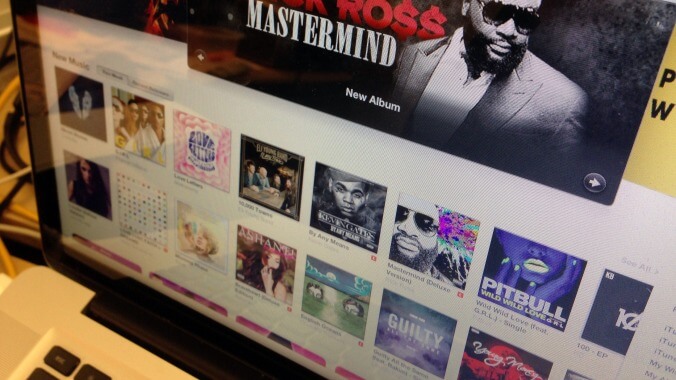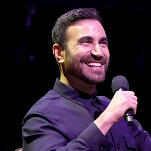You could spend hours walking the aisles of a record store in 2000. Vinyl records had long been relegated to the gift and collectors’ sections to make room for discs a quarter of their size, but these depositories of physical media were still full of shelf after shelf of music to discover. Folks lined up for days to be among the first to get their hands on the latest big release, and labels jockeyed for prime placement at the end of an aisle by sending life-size cutouts of their marquee stars. Record stores served as both gateways and gatekeepers in introducing new music to the masses. If it wasn’t offered at your local Sam Goody, the best you were getting was a janky live recording or a mixtape with unwanted cameos from your local radio DJ. Then came Napster.
Launched in May 1999 by Shawn Fanning and Sean Parker, Napster began as a tiny startup out of Hull, Massachusetts. The founders, still just teenagers, had met in a chatroom a few years prior and bonded over their common vision of making it easier for people to share their personal music libraries with others online. By that October, Napster—also Fanning’s childhood nickname, due to his curly hair—had more than 4 million songs available for peer-to-peer file sharing. And by May 2000, Fanning and Parker had moved to Silicon Valley and more than 20 million people were using the service to share their previously private collections of beloved, rare tracks and new releases while downloading guilty pleasures like the Grease 2 soundtrack. (Just me?) That was the magic of Napster in the days before anyone worried about the ethics of it all: Suddenly, music was free and available to anyone with a modem. Napster democratized access to lesser-known artists and released consumers from the monetary concerns that may have kept them from checking out that Chumbawamba album they weren’t sure they wanted, having only heard “Tubthumping.” (In retrospect, I was probably fine without that one.)
But it wasn’t just the latest releases and long-forgotten B-sides that users were swapping. Occasionally, a track—or entire album—would leak ahead of its official release. Madonna’s “Music” was a particularly high-profile unauthorized preview. When an unfinished version of the single found its way onto Napster in June 2000, the singer penned an open letter about her disappointment in Icon magazine. Metallica and Dr. Dre took things a step further, actually filing suit against Napster for copyright infringement in the spring of 2000. And they were not alone in their ire: Much of the music industry decried Napster and its peer-to-peer kin as grim reapers and lamented that these leaks and the unmonetized access were eating into their well-earned profits. In addition to the lawsuits against Napster, record labels sued individual users and launched a public anti-piracy advertising campaign. (It actually wasn’t the first time the music industry spoke up about the issue: In the early 1980s, as blank cassette tapes became more readily available, record labels began slapping warnings on their products that read “Home Taping Is Killing Music.” Its cousins “Don’t Copy That Floppy” and “Piracy. It’s A Crime” would come in the decades to follow.)
But file-sharing services also provided unprecedented word-of-mouth buzz for artists who had yet to find global success. Unlike Madonna or Metallica, modern-rock darlings Radiohead had yet to fully crossover to the mainstream when their fourth studio album, Kid A, leaked online a few weeks ahead of its October 2000 release. Lead single “Optimistic” was getting solid modern-rock radio play, but the critically acclaimed English rock band hadn’t released a U.S. top-10 track since 1992’s “Creep.” Kid A was radical diversion from Radiohead’s past work, a full-on embrace of the electronic textures they’d only flirted with in the past, but it was still expected to perform similar to the band’s most recent album, OK Computer, and top out around the mid-20s on the Billboard 200. Instead, Kid A debuted at No. 1, easily besting offerings from Mystikal, Nelly, and Green Day. Much of that success was credited to Napster, since there was very little promotion for the album aside from a few 30-second MTV spots, a couple of intimate concerts, and a Saturday Night Live appearance. Even the band’s label, Capitol/EMI, agreed. “We didn’t use Napster. We wanted to keep [Kid A] off Napster,” the label’s vice president of marketing, Rob Gordon, said in Spin’s January 2001 issue. “But when it went up, did it create more excitement, more enthusiasm? Absolutely.”
The following year would bring Radiohead their second Grammy, but also the end of Napster as we knew it. At the height of its popularity—anywhere from 26.4 million to 80 million users, depending on the source—Napster was shut down when the Ninth Circuit Court of Appeals ruled in favor of several major record labels that had sued the service over copyright infringement. (Napster later settled the suits filed by Metallica and Dr. Dre.) “There was a weekend…that felt like the last days of Rome,” The Guardian’s Tom Lamont wrote in 2013 of the warning Napster users got before the service was shut down in March 2001. “There were 48 hours of free music left and I remember the panic… Would there ever be such an opportunity again?”
The short answer to Lamont’s question was “no,” but the courts’ crackdown didn’t immediately halt unauthorized free access to music and video files. Rather, it sent users scurrying to other P2P services like LimeWire and BitTorrent sites like the Pirate Bay, which would prosper for another decade yet.
The music industry also got smarter. Madonna—not to be foiled again—had seemingly leaked tracks off American Life posted on KaZaA ahead of the 2003 album’s release, but when users downloaded and played the files, all they heard was the singer saying “What the fuck do you think you’re doing?” Nevertheless, she was outsmarted: A few days after Madonna’s prank, a hacker took over madonna.com, posting a message that read “This is what the fuck I think I’m doing” along with links to MP3s of the actual American Life album.
The public had gotten a taste of instant digital consumption, and the industry had to adjust. In 2002, Apple co-founder Steve Jobs reached an agreement with the five major record labels to offer their content for purchase through iTunes—a natural progression for Apple, since they’d given everyone a way to carry those digital music files with them, in the form of the first iPod, in October 2001. Radiohead even returned to an online-first release, this time intentionally: In 2007, the band released In Rainbows as a pay-what-you-want digital download (at that point they emailed you a .zip file) three months before making it available on CD and vinyl.
“This desire to use the technology was driven by distrust and frustration with trying to broadcast our music via traditional media, such as radio and television,” Radiohead’s Colin Greenwood wrote for Index On Censorship in 2010. “Music on television is scarce, and hard to do well. Radio has such regulated playlists that disc jockeys are lucky to have one free play per show. Why go exclusively through such straitened formats when you could broadcast directly to people who are interested in you, in that moment?” At the time, the move was seen as revolutionary, a way to short-circuit piracy and ensure artists were still being paid at a time when music sales were sharply declining. But what went largely unspoken was that the pay-what-you-want strategy could only be profitable for an act with a fanbase as large and fervent as Radiohead’s, which had expanded tremendously in the years since Kid A. The faltering industry wouldn’t truly stabilize until the development of subscription streaming services like Spotify and Apple Music—which could still be doing more to make sure the artists are being paid.
It’s no longer the Wild West days of Napster, but—for better or worse—that renegade service flipped the entire entertainment industry on its head and expedited its digital revolution. Compact disc sales continue to decline (down to 46.5 million CDs in 2019 compared to the industry high of almost 950 million in 2000), but now millions of tracks are available at our fingertips for just a small monthly fee or after a short ad on YouTube. If today’s teenager wants to listen to the latest Taylor Swift album the moment its released, they can. If they want to dive deep into Aboriginal tribal music, they can. The record-store doors are closed, but the gates are wide open for us to enjoy music like never before. Just maybe don’t go to a concert until this whole pandemic is over, please.








































